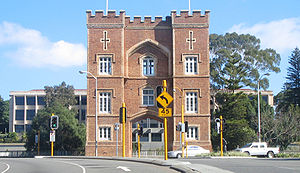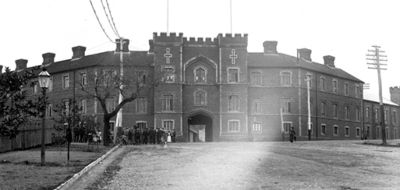
The Barracks Arch
Encyclopedia

Perth, Western Australia
Perth is the capital and largest city of the Australian state of Western Australia and the fourth most populous city in Australia. The Perth metropolitan area has an estimated population of almost 1,700,000....
, Western Australia
Western Australia
Western Australia is a state of Australia, occupying the entire western third of the Australian continent. It is bounded by the Indian Ocean to the north and west, the Great Australian Bight and Indian Ocean to the south, the Northern Territory to the north-east and South Australia to the south-east...
. It effectively blocks a clear view from Parliament House down St George's Terrace.
The Barracks
Designed by Richard Roach JewellRichard Roach Jewell
Richard Roach Jewell was an architect who designed many of the important public buildings in Perth during the latter half of the nineteenth century....
, the Barracks were originally built in 1866 to house the retired Enrolled Pensioner Force. The Enrolled Pensioner Force came to Australia as guards on convict
Convict
A convict is "a person found guilty of a crime and sentenced by a court" or "a person serving a sentence in prison", sometimes referred to in slang as simply a "con". Convicts are often called prisoners or inmates. Persons convicted and sentenced to non-custodial sentences often are not termed...
ships, and were given small land grants in return for part-time guard work. The bulk of convict work moved from Fremantle
Fremantle, Western Australia
Fremantle is a city in Western Australia, located at the mouth of the Swan River. Fremantle Harbour serves as the port of Perth, the state capital. Fremantle was the first area settled by the Swan River colonists in 1829...
to Perth in the 1860s, so there was a need to accommodate many Enrolled Pensioners and their families.

Architect
An architect is a person trained in the planning, design and oversight of the construction of buildings. To practice architecture means to offer or render services in connection with the design and construction of a building, or group of buildings and the space within the site surrounding the...
Jewell designed the three-storey building in Tudor
Tudor style architecture
The Tudor architectural style is the final development of medieval architecture during the Tudor period and even beyond, for conservative college patrons...
style that resembled a medieval castle. The building was brick, rather than more expensive stone, and horizontal lines emphasised by using lines of paler colour bricks underneath the windows. The roof was made of timber shingles. The building was finished in 1866, and was later extended to house an additional 21 families. Each family apartment had two rooms, each about 13 feet by 11 feet, with at least one fireplace. The outbuildings included a cook house, firing range and gun room, wash house, stores and stables, and a fives
Fives
Fives is a British sport believed to derive from the same origins as many racquet sports. In fives, a ball is propelled against the walls of a special court using gloved or bare hands as though they were a racquet.-Background:...
court constructed later.
A fire in 1887 destroyed the timber flooring of the east wing and the second floor of the central section. Water was pumped by hand pumps from the Swan River
Swan River (Western Australia)
The Swan River estuary flows through the city of Perth, in the south west of Western Australia. Its lower reaches are relatively wide and deep, with few constrictions, while the upper reaches are usually quite narrow and shallow....
and brought by buckets through a chain of volunteers. The burnt sections were later restored.
The Barracks was gradually converted to offices for the Public Works Department between 1900 and 1904. The fives court housed the drawing office, and eventually connected to a mid-1920s addition for the Metropolitan Water Supply, Sewerage and Drainage department. The Public Works Department and Metropolitan Water Board moved to Dumas House
Dumas House
Dumas House is a fourteen storey office building constructed in Perth, Western Australia during the 1960s. The building is located close to St Georges Terrace, Kings Park, and Parliament House....
in March 1966.
Demolition of the Barracks and retention of the Arch

Mitchell Freeway
Mitchell Freeway is a long freeway in Perth, Western Australia, linking Perth's central business district with its outer northern suburbs. It is allocated Route 2 for its entire length and is named after former state Premier and Governor Sir James Mitchell....
, after the departments moved to their new location. The Royal Western Australian Historical Society
Royal Western Australian Historical Society
Royal Western Australian Historical Society has for many decades been the main association for Western Australians to collectively work for adequate understanding and protection of the cultural heritage of Perth and Western Australia...
formed a Barracks Defence Council in 1961, and joined the public outcry against demolition in 1966. The Barracks Defence Council worked to keep the arch and five bays of windows either side, and at worst, keep only the gateway and towers. Meanwhile, demolition proceeded, with the third and fourth bays of windows demolished and rubble cleared.
Opinion polls were conducted to gauge the public's preferences. A March 1966 poll by radio station 6IX received 2,747 votes to retain the Arch and 59 votes for demolition. The West Australian
The West Australian
The West Australian is the only locally-edited daily newspaper published in Perth, Western Australia, and is owned by ASX-listed Seven West Media . The West is published in tabloid format, as is the state's other major newspaper, The Sunday Times, a News Limited publication...
newspaper's July poll recorded 9,681 votes for retention and 1345 against. Cabinet authorised a Gallup poll, which showed 49% of votes for retention, 35% against, 11% no opinion, and 5% for moving the Arch elsewhere. The Premier, Sir David Brand, interpreted the results as indecisive, and declared Parliament would decide on the Arch's fate on a non-party basis. The motion to demolish the Arch was defeated on 19 October, 1966, by 26 votes to 18.
The Public Works Department retained the Arch and landscaped the surrounding area.
Further reading
- Reid, G. S. . (1980) Perth's arch wrangle : the case of the Barracks Arch. Government 2, Vol.2, appendices 1-11

